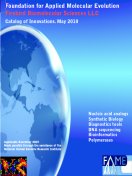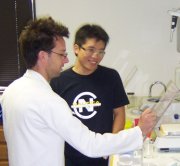-
Research
-
Publications
-
All publications
-
Benner, SA
-
Carrigan, MA
-
Chamberlin, SG
-
Hoshika, S
-
Hutter, D
-
Karalkar, N
-
Kim, HJ
-
Kim, MJ
-
Laos, R
-
Leal, NA
-
Lyons, TJ
-
Moussatche, P
-
Shaw, RW
-
Yang, ZY
-
People
-
Benner, Steven
-
Carrigan, Matthew
-
Chamberlin, Stephen
-
Davis, Ross
-
Hoshika, Shuichi
-
Hughes, Romaine
-
Hutter, Daniel
-
Karalkar, Nilesh
-
Kim, Hyo-Joong
-
Kim, Myong-Jung
-
Laos, Roberto
-
Leal, Nicole
-
Lyons, Thomas
-
Moussatche, Patricia
-
Opalko, Jeff
-
Shaw, Ryan
-
Yang, Zunyi
-
Software
-
News and Events
-
Press Coverage
-
Blog
-
Our Foundation
Reagents for sale!
 (disclaimer)
(disclaimer)
All products sold by FfAME, Inc., are for research and development purposes only, and are not for use in humans. It is the responsibility of the buyer to determine the suitability of the product for any given purpose. Products should be handled by trained personnel who understand the potential hazards of working with such materials. Responsibility for accidents arising from the handling and use of Firebird/FfAME's products rests solely with the buyer.
|
Fellow
Matthew Carrigan
Education
- BS in Biochemistry and Molecular Biology (minors: Anthropology, Religion, Chemistry). University of Florida (1997)
- PhD in Biomedical Sciences, concentration in Neuroscience, Molecular Evolution and Origins of Complex Biological Systems,. University of Florida (2002)
Research summary
My research focuses on the origin of life, both in an evolutionary/historical sense ("how did life as we know it begin?"), and from a synthetic biology perspective ("how might we synthesize a living system, and how might its chemistry differ from natural life?"). These questions are addressed experimentally through examining pre-biotic chemical mechanisms for obtaining the building blocks of natural life, with a focus on nucleic acids. Current efforts focus on the synthesis and stability of the sugar backbone of RNA (ribose) and the polymerization of ribonucleotides. My second research focus is on selection of novel catalytic nucleic acid polymers from random sequence. We currently aim to isolate an RNA enzyme (ribozyme) capable of RNA polymerization. Through both research pursuits, we gain understanding of the factors that constrain spontaneous biogenesis.
Recent Publications

2-Hydroxymethylboronate as a Reagent To Detect Carbohydrates: Application to the Analysis of the Formose Reaction
Ricardo, A; Frye, F; Carrigan, MA; Tipton, JD; Powell, DH; Benner, SA
J. Org. Chem.
71 (25) 9503-9505 (2006)
<Abstract>
2-Hydroxymethylphenylboronate is described as a reagent that converts neutral 1,2-diols, as found in simple carbohydrates, into 1:1 anionic complexes that are easily detected by Fourier transform ion cyclotron resonance mass spectrometry. The value of this reagent was demonstrated through its application to analyze complex mixtures of carbohydrates formed in the formose process, often cited as a way that biologically significant carbohydrates might have been generated from formaldehyde under prebiotic conditions. Coupled with isotope studies, the reagent shows that the simplest autocatalytic cycle for the consumption of formaldehyde in this process cannot account for the bulk consumption of formaldehyde.

Quantitative analysis of a RNA-cleaving DNA catalyst obtained via in vitro selection
Carrigan, MA; Ricardo, A; Ang, DN; Benner, SA
Biochemistry
43 (36) 11446-11459 (2004)
<Abstract>
In vitro selections performed in the presence of Mg2+ generated DNA sequences capable of cleaving an internal ribonucleoside linkage. Several of these, surprisingly, displayed intermolecular catalysis and catalysis independent of Mg2+, features that the selection protocol was not explicitly designed to select. A detailed physical organic analysis was applied to one of these DNAzymes, termed 614. First, the progress curve for the reaction was dissected to identify factors that prevented the molecule from displaying clean first-order transformation kinetics and 100% conversion. Several factors were identified and quantitated, including (a) competitive intra- and intermolecular rate processes, (b) alternative reactive and unreactive conformations, and (c) mutations within the catalyst. Other factors were excluded, including "approach to equilibrium" kinetics and product inhibition. The possibility of complementary strand inhibition was demonstrated but was shown to not be a factor under the conditions of these experiments. The rates of the intra- and intermolecular processes were compared, and saturation models for the intermolecular process were built. The rate-limiting step for the intermolecular reaction was found to be the association/ folding of the enzyme with the substrate and not the cleavage step. The DNAzyme 614 is more active in trans than in cis and more active at temperatures below the selection temperature than at the selection temperature. Many of these properties have not been reported in similar systems; these results therefore expand the phenomenology known for this class of DNA-based catalysts. A brief survey of other catalysts arising from this selection found other Mg2+-independent DNAzymes and provided a preliminary view of the ruggedness of the landscape, relating function to structure in sequence space. Hypotheses are suggested to account for the fact that a selection in the presence of Mg2+ did not exploit this Mg2+. This study of a specific catalytically active DNAzyme is an example of studies that will be necessary generally to permit in vitro selection to help us understand the distribution of function in sequence space.

Is there a common chemical model for life in the universe?
Benner, SA; Ricardo, A; Carrigan, MA
Curr. Op. Chem Biol.
8 (6) 672-689 (2004)
<Abstract>
A review of organic chemistry suggests that life, a chemical system capable of Darwinian evolution, may exist in a wide range of environments. These include non-aqueous solvent systems at low temperatures, or even supercritical dihydrogen-helium mixtures. The only absolute requirements may be a thermodynamic disequilibrium and temperatures consistent with chemical bonding. A solvent system, availability of elements such as carbon, hydrogen, oxygen and nitrogen, certain thermodynamic features of metabolic pathways, and the opportunity for isolation, may also define habitable environments. If we constrain life to water, more specific criteria can be proposed, including soluble metabolites, genetic materials with repeating charges, and a well defined temperature range.

A statistical view of FMRFamide neuropeptide diversity
Espinoza, E; Carrigan, M; Thomas, SG; Shaw, G; Edison, AS
Mol. Neurobiol.
21 35-56 (2000)
<Abstract>
FMRFamide-like peptide (FLP) amino acid sequences have been collected and statistically analyzed. FLP amino acid composition as a function of position in the peptide is graphically presented for several major phyla. Results of total amino acid composition and frequencies of pairs of FLP amino acids have been computed and compared with corresponding values from the entire GenBank protein sequence database. The data for pairwise distributions of amino acids should help in future structure-function studies of FLPs. To aid in future peptide discovery, a computer program and search protocol was developed to identify FLPs from the GenBank protein database without the use of keywords.

Sequence analysis of FMRFamide-like peptides and precursors
Carrigan, M; Espinoza, E; Thomas, S; Benner, SA; Edison, AS
Brain Res.
848 (1999)

Targeting determinants and proposed evolutionary basis for the sec and the delta pH protein transport systems in chloroplast thylakoid membranes
Henry, R; Carrigan, M; McCaffery, M; Ma, XY; Cline, K
J. Cell. Biol.
136 (4) 823-832 (1997)
<Abstract>
Transport of proteins to the thylakoid lumen is accomplished by two precursor-specific pathways, the Sec and the unique Delta pH transport systems, Pathway selection is specified by transient lumen-targeting domains (LTDs) on precursor proteins. Here, chimeric and mutant LTDs were used to identify elements responsible for targeting specificity, The results showed that: (n) minimal signal peptide motifs consisting of charged N, hydrophobic H, and cleavage C domains were both necessary and sufficient for pathway-specific targeting; (b) exclusive targeting to the Delta pH pathway requires a twin arginine in the N domain and an H domain that is incompatible with the Sec pathway; (c) exclusive targeting to the Sec pathway is achieved by an N domain that lacks the twin arginine, although the twin arginine was completely compatible with the Sec system, A dual-targeting signal peptide, constructed by combining Delta pH and Sec domains, was used to simultaneously compare the transport capability of both pathways when confronted with different passenger proteins. Whereas Sec passengers were efficiently transported by both pathways, Delta pH passengers were arrested in translocation on the Sec pathway, This finding suggests that the Delta pH mechanism evolved to accommodate transport of proteins incompatible with the thylakoid Sec machinery.
(View all publications by Matthew Carrigan)
|
- Origins and Evolution of Life
- Synthetic Biology
- Paleo-biochemistry
- Science outreach and teaching
- Interface between 'Science' and 'Theology'
|
|
 (disclaimer)
(disclaimer)








